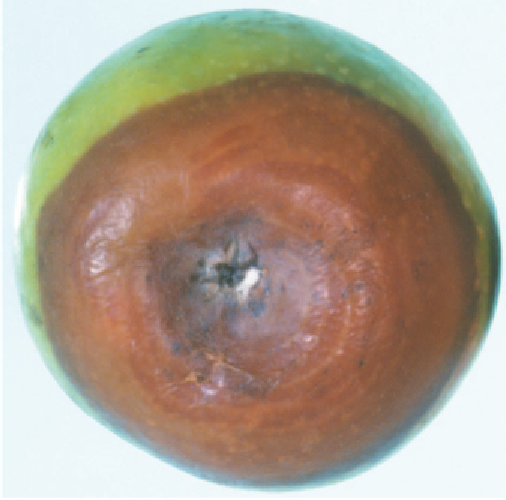Agriculture Reference
In-Depth Information
Importance
Bitter rot is a common disease that may become serious
as fruit nears maturity. With a reduction in use of
broad-spectrum fungicides this disease may become more
prevalent.
Management
•
During winter, remove all mummifi ed fruit and
infected fruiting twigs or 'spurs' during pruning and
destroy.
Apply protectant fungicides from early November.
•
BLACK ROT OF APPLE
■
Cause
The fungus
Botryosphaeria ribis
.
Fig 3.14 Symptoms of bitter rot on apple.
Symptoms
The disease can affect wood, leaves and fruit.
Branches: small, elliptical areas develop; the bark shrinks,
lightens in colour, and then becomes sunken and separated
from healthy bark by a crevice. The fungus grows radially
so that in old cankers there may be a number of crevices
arranged concentrically. Eventually, the branch becomes
girdled and dies.
raised masses of spores appear. They are initially black-
brown, ripening to pink and often in concentric rings. The
spots generally appear when the fruit approach maturity.
Fruiting twigs or 'spurs' occasionally develop cankers.
Small, irregular brown leaf spots appear during periods
of warm wet weather.
Source of infection and spread
The fungus overwinters on mummified diseased fruit
left on the trees, on infected spurs from the previous
season, and in bark crevices. Spores released from these
sources in warm, wet weather during late spring and
summer continue to infect fruit. Pink spore masses then
develop on these fruit, providing large numbers of spores
for further spread. Ripe fruit near harvest are very
susceptible.
Leaves: greyish-brown spots with darker surrounding zones
occur, giving a frogeye appearance.
Fig 3.16 Black rot on apple showing dark fruiting bodies in infected
tissue.
Fig 3.15 Gelatinous spore masses of bitter rot infection on fruit.














